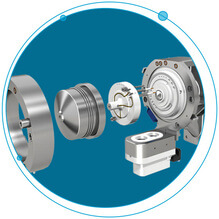 Mass spectrometry can provide exceptional sensitivity, selectivity, resolution, throughput, and mass accuracy, but certain applications demand additional levels of selectivity. This is where differential ion mobility technology comes in. It delivers highly-selective, robust and powerful ion separation, adding analytical performance to your existing technology.
Mass spectrometry can provide exceptional sensitivity, selectivity, resolution, throughput, and mass accuracy, but certain applications demand additional levels of selectivity. This is where differential ion mobility technology comes in. It delivers highly-selective, robust and powerful ion separation, adding analytical performance to your existing technology.
Discover the Benefits of SelexION® DMS for Your Workflow Challenges
1. Lipidomics: Do you find unambiguous identification and quantitation of lipid molecular species in total lipid extracts difficult due to overlapping isobaric and isomeric species? SelexION technology can resolve multiple lipid classes from complex lipid matrices prior to MS analysis to enable more confident identification of lipid species and more accurate quantitation by MS/MS.
Read more in this tech note on, Differential Mobility Separation for Improving Lipidomics Analysis by Mass Spectrometry >
2. Peptide and Protein Quantitation: Do your peptides and proteins suffer from interferences, poor fragmentation, and lack of quality unique peptides compared to background? SelexION technology can be used to help remove sample interferences and separate isobaric peptide species, resulting in more sensitive and selective detection and quantitation of large molecule targets.
Read more in this tech note on, Benefits of Differential Ion Mobility Spectrometry for High-Sensitivity Quantification of
Peptides >
3. Small Molecule Bioanalysis and Metabolism: Are you struggling to achieve accurate and robust quantitation of small molecule therapeutics and metabolites, often complicated by matrix interferences, high baseline signal, and lack of isomer resolution? SelexION technology enables robust and reproducible bioanalytical methods, without running complex HPLC conditions or sample preparation.
Read more in this tech note on, A New Solution to Selectivity Challenges in Quantitative Bioanalysis >
4. Food and Environmental Testing: Are you challenged by compounds that need to be analyzed by regulatory agencies, but are difficult to reproducibly detect due to complex matrices? SelexION technology delivers an additional level of separation for robust and reproducible detection of food and environmental contaminants that satisfies governing bodies all over the world.
Read more in this tech note on, Increasing Selectivity and Confidence in Detection when Analyzing Phthalates by LC-MS/MS >
5. Forensics: Are your forensic analytes difficult to accurately detect because of the complexity of matrices or the presence of chemical interferences? Getting the right answer is crucial to your forensic investigation. SelexION technology can reduce chemical noise and improve quantitative accuracy to rapidly deliver the accurate data you need.
Read more in this tech note on, Investigating the Enhancement in Selectivity for the Analysis of Methyldienolone in Urine Samples by Differential Mobility Spectrometry >
Download our eBook packed with technical articles and application notes, to learn how SelexION DMS Technology can enhance results in the key application areas explored above.
SelexION supports highly selective quantitative and qualitative LC-MS/MS workflows on SCIEX Triple Quad™, QTRAP®, or TripleTOF® Systems. It can separate analytes of identical mass, reduce chemical noise, and improve quantitative accuracy, to rapidly deliver the data you need.
Read the first blog in this series to understand the science behind the SelexION device and find out how it addresses your biggest analytical challenges.






 Contact Support
Contact Support
0 Comments